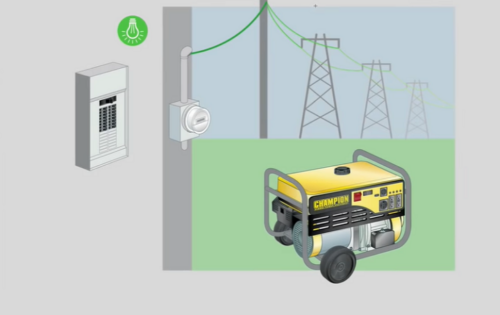Photo Source : homegenerate.com
Using a generator can be a great way to keep your home powered up in the event of a power outage. But what do you do if you don’t have a transfer switch? Don’t worry, it’s still possible to hook up your generator to your home without one.
In this guide, we’ll show you how to do just that. We’ll also provide some tips on how to get the most out of your generator and keep your home safe while using it. So without further ado, let’s get started.
How To Prepare Before Hooking Up A Generator

Photo Source : homeprofy.com
Before you start connecting your generator to your home, there are a few things you need to do first.
1. Read the Owner’s Manual
This might seem like an obvious one, but it’s important nonetheless. Every generator is different, and each one has its own set of instructions.
2. Choose a Safe Location for the Generator
You’ll want to place your generator in a safe, well-ventilated location. This will help to prevent carbon monoxide buildup.
3. Make Sure the Generator Is Grounded
For safety reasons, you’ll want to make sure that your generator is properly grounded. You can do this by using a ground rod or by connecting the generator to a cold water pipe.
4. Fill the Generator with Fuel
You’ll need to have enough fuel on hand to keep your generator running for at least 24 hours. This will give you enough time to find more fuel if needed.
5. Check the Oil Level
Before starting your generator, you should always check the oil level. This will help to ensure that your generator is running smoothly and efficiently.
6. Turn Off All Circuit Breakers
Once you’ve done all of the above, you’re ready to start hooking up your generator. But first, you’ll need to turn off all the circuit breakers in your home. This will prevent any damage to your appliances or outlets.
What Do You Need In Hooking Up Generator To House Without Transfer Switch

Photo Source : genhub.com
Now that you’ve prepared everything, it’s time to start hooking up your generator. But what do you need?
- A generator, of course!
- An extension cord. The length will depend on how far away your generator is from your home.
- A power inlet box. This will be used to connect your generator to your home’s electrical system.
- A subpanel. This will be used to connect your generator to your home’s main electrical panel.
- A transfer switch. This is not strictly necessary, but it will make things easier and safer.
How To Hook Up Generator To House Without Transfer Switch
Now that you have everything you need, it’s time to start hooking up your generator.
1. Connect the generator to the power inlet box.
You will need to use an extension cord to do this. The cord should be long enough to reach from the generator to the power inlet box.
2. Connect the power inlet box to the subpanel.
Again, you will need to use an extension cord for this. This will provide power to the subpanel.
3. Connect the subpanel to the main electrical panel.
You will need to use a transfer switch for this. The transfer switch will allow you to safely and easily connect the generator to your home’s electrical system.
4. Turn on the generator.
Once everything is connected, you can now turn on the generator. Be sure to start with the main breaker off. Then, you can slowly turn on each breaker, one at a time.
5. Flip the circuit breakers in your home one by one.
This will allow each appliance or outlet to receive power from the generator.
6. Enjoy your power!
You should now have power from your generator. Remember to exercise caution when using electrical appliances. And always keep an eye
Tips For Using Your Generator Safely

Photo Source : eletricalportal.com
Now that you know how to hook up your generator without a transfer switch, there are a few things you should keep in mind to use it safely.
Never Run the Generator Indoors
Running a generator indoors can be extremely dangerous. Carbon monoxide fumes can quickly build up and cause serious health problems, or even death.
Only Use Approved Cords and Plugs
To prevent fires and other accidents, only use cords and plugs that are approved for use with generators.
Don’t Overload the Generator
Trying to run too many appliances or devices off of your generator can damage both the generator and the devices. Make sure you know how much power your generator can handle before hooking everything up.
Keep an Eye on the Fuel Level
Running out of fuel is one of the most common causes of generator problems. Always keep an eye on the fuel level and make sure there’s enough to keep the generator running.
Shut Off the Generator Before Refueling
Refueling a generator while it’s running can be extremely dangerous. Make sure you shut off the generator and let it cool down before adding more fuel.
Final Thoughts
Hooking up a generator without a transfer switch can be dangerous if you don’t know what you’re doing. But if you follow the steps in this guide, you can safely and easily connect your generator to your home’s electrical system. Just remember to exercise caution and never run the generator indoors.

I am Andre Smith, the founder of generatorsdaily.com. I have been passionate about generators and their uses since my early teenage years. Through this blog, I share my knowledge of the different types of generators available, as well as insights into how to effectively use them for the best results. My team and I are always staying ahead of the curve and updating our content to ensure our readers have the most up-to-date information. We strive to become a go-to resource in the generator industry.


